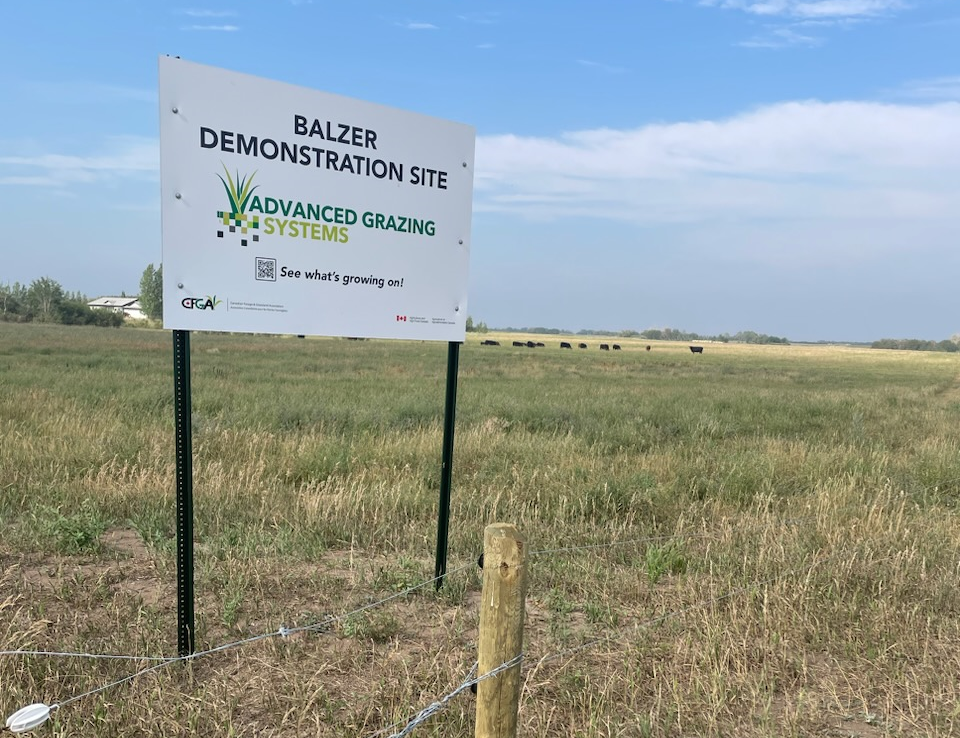Steven Balzer demonstration site set-up and design.

.png)
Site Background
About the Location
The Steven Balzer Demonstration Site is located approximately three kilometres south of Langham, Saskatchewan, in the Moist Mixed Grassland ecoregion of Saskatchewan; however it is in close proximity to the Aspen Parkland region. The Moist Mixed Grassland ecoregion is the transitioning region between the semi-arid Mixed Grassland ecoregion and the Aspen Parkland ecoregion, comprising the northern most extension of the Great Plains of North America.
Dark Brown Chernozemic soils dominate this area and are home to mid-height grasses and sedges, including needle-and-thread, and western wheatgrasses along with Prairie Junegrass and blue grama sedges. These grasses contribute to the five to six per cent organic matter of the soil and also play an active role in the carbon sequestration cycle.
Aspen groves can be found to a limited extent on shaded valley slopes, with aspen, willow, cottonwood and box-elder species. Since natural water sources in this site are semi permanent and often run dry mid to late summer, water is hauled in for livestock to utilize.
Topography of this site has allowed many aspen groves to be present, offering many benefits, including livestock shelter and snow accumulation. The Moist Mixed Grassland ecoregion typically sees 350 to 400 millimeters of rainfall; however, being located in the northern tip of the ecoregion, this site may see a slightly increased amount of moisture. Average temperatures include a summer mean of 15.5°C and a winter mean of -11°C.
Learning About Rotational Grazing
Rotational grazing became of interest after Steven took an Advanced Grazing Workshop with mentor Lee Sexton. He easily grasped the Advanced Grazing Systems (AGS) concepts and implemented the technology on his property.
After completing the AGS course with Lee, Steven submitted a project through the Canadian Forage and Grassland Association (CFGA) On-Farm Climate Action Fund (OFCAF) program. Unfortunately the program funds were depleted before the project could be reviewed. It was noted for its merit and when a site was needed for the Ag In Motion event, CFGA reached out to Steven to discuss development of his project for demonstration.
Steven began this farming operation in 2017 and the following year began using the planned grazing method on his farm. The desire to raise more cattle on the same amount of land was the driving factor for the switch. In the six years of operating with Advanced Grazing Systems (AGS) concepts, the most beneficial change he has noticed has been the improved soil health and the forage production abilities of his land. Managing the time allotment for the cross fence paddocks and changing his own learned habits from conventional grazing methods has been the only notable challenges he has experienced since switching to the AGS method. When asked about future plans for his operation he shared that there is always more plans, but more permanent fencing and increasing the use of temporary electric fence are current short term goals. Steven shared that the expected benefits of the AGS method appear more quickly than anticipated, so just start!
The Rotational Grazing Objective
This project aims to demonstrate a simple advanced grazing system. It aims to present options for integrating cattle in the landscape, promoting permanent cover and grassland retention, particularly addressing animal distribution and utilization concerns.
Acknowledgements
University of Saskatchewan. 2008. Virtual Herbarium of Plants at Risk in Saskatchewan: A Natural Heritage.
Government of Saskatchewan. 2023. Prairie Landscape Inventory- Moist Mixed Grassland Classification.
Agronomic Details
The site includes 98 acres of established tame pasture, with undeveloped grazing infrastructure. Steven proceeded with his project prior to agreeing to host the CFGA demonstration site, completing a four-strand barbed wire fence (in red), separating the 45-acre, treed portion from the pasture.
Steven’s proposal was adapted slightly by installing an alley for accessing water and to improve the adaptability of the mobile Razer Grazer ™ temporary fencing unit (in green) to divide the pasture into approximately sixteen three-day grazing parcels, providing 48 days rest for the pasture.
No fertilizers have been added to this pasture. The soil is a clay/ loam texture with a small pocket of sandier land around dugout. In this pasture, alfalfa and brome are the most prominent forb and grass and are the most favoured plants in the pasture stand. Wolf willow are the most prominent shrubs. The least desired plant in this pasture is absinthe. Balzer’s are looking to improve the cattle distribution in this pasture to prevent extended time at the dugout.
This demonstration site grazes angus replacement heifers, with a spring weigh of 700lbs and a fall weights of 950+lbs.
Key dates to take not of for this demonstration site are;
April - Heifers put on pasture with supplemental bales
May 20 - Bulls turned out
Water infrastructure proposed for this site includes developing a wet well at the dugout on the west side of the pasture and a pumping system installed to deliver water to a watering alley in the central portion of the undeveloped tame pasture. For the purpose of the demo, water will be provided by Elliot Tree Services and a water truck, supplied by Steven. Flowline and water troughs will be provided for the purpose of the demo with Steven developing the wet well and installing the pumping system in the following grazing season.
Elliot Tree Services will haul water a minimum of one time per week to a 1,250-gallon tank they will provide to supply water for the cattle at the site.
Fencing and water-line installation was completed on the demonstration site on June 26 to 28, 2023.
Funding for this project in part has been provided by Agriculture and Agri-Food Canada through the Agricultural Climate Solutions – On-Farm Climate Action Fund.


















